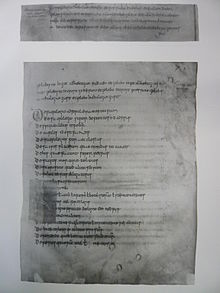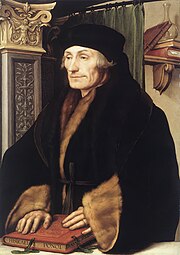History of religion in the Netherlands
This article needs additional citations for verification. (July 2020) |

The history of religion in the Netherlands has been characterized by considerable diversity of religious thought and practice. From 1600 until the second half of the 20th century, the north and west had embraced the
Since the 1960s, the Netherlands has become one of the most secular countries in the Western world. In a December 2014 survey by

Prehistory and Early Middle Ages
Before the advent of Christianity, the Netherlands were populated by
The oldest data on the profession of religion by the inhabitants of the regions that are now the "
From the 4th to the 6th century AD,
At the start of the 6th century, the first (Hiberno-Scottish) missionaries arrived. They were later replaced by Anglo-Saxon missionaries, who eventually succeeded in converting most of the inhabitants of the southern Netherlands to Christianity by the 8th century.
From the late 7th century, missionaries coming from
In the 8th century, Anglo-Saxon missionaries such as

High and Late Middle Ages

Religious life was ubiquitous in
Where justice until the 12th century existed largely in actions by
Reformation in the Early Modern Period
This section needs additional citations for verification. (July 2020) |


Catholicism dominated Dutch religion until the early 16th century, when the
The most prominent Dutch theologian was the


The 16th and 17th century were characterized by the Protestant Reformation, which greatly influenced the history of the Netherlands, especially in western and northern areas of the country. They also had influence with the eastern English shires, with which they were in contact through trading across the North Sea. The first wave of Reformation, initiated by Luther, did not come to the Netherlands.
The second wave of the Protestant Reformation,
The third wave of the Reformation,
The counties of Holland and
Philip II of Spain was the hereditary ruler of the Netherlands. As a devout Catholic, Philip believed he was obligated to fight Protestantism, which also threatened his rule. After the Beeldenstorm, he sent troops to suppress Protestantism in the Netherlands. The Spanish conquered the southern Netherlands (Flanders and Brabant). Protestants in this area, many of them prosperous merchants, fled en masse to Holland, Zeeland, and Friesland. An extreme example was the city of Hondschoote, where the population dropped from 18,000 to 385 inhabitants. Antwerp, formerly the most powerful city in the Low Countries, lost more than half its residents to this exodus.[5]
In the Calvinist-controlled northern counties, many of the remaining Catholics were tending toward converting to Protestantism for temporal gain, to survive in the changed society. In the early 17th century, the Roman Catholic
At the same time, the larger western cities received an influx of Protestant immigrants from
During the
In 1648, Spain and the
English Puritans in Amsterdam formed what was known as the "Ancient Church of Amsterdam", whose leaders included wealthy merchants such as
19th century


During the 19th century, there was a rising conflict among Catholics, liberal Calvinists, and orthodox Calvinists. The Dutch solution, known as
Following the invasion of forces of Revolutionary France in 1795, the Batavian Republic was established for a time, creating equal rights for all religious groups in the Netherlands. In 1813, the Calvinist Republic united with the Catholic Southern Netherlands to form the United Kingdom of the Netherlands.
The union split in 1830 after the Belgian Revolution, which was partially motivated by religious differences between Protestants and Catholics, as well as by the political split between Orangists (royalists) and Liberals (mainly from Brussels and Ghent). The position of Catholics in the Kingdom of the Netherlands worsened. The Catholic episcopal hierarchy was forbidden and Catholics were forbidden to hold religious processions in all provinces except for Noord Brabant and Limburg.
A liberal Calvinist elite dominated the Netherlands for a period, including the national bureaucracy and the
Roughly fifty years later, in 1886, another group of orthodox Calvinists, led by
During this period Catholics began to develop their own non-governmental institutions. The Netherlands became dominated among three religious pillars, an orthodox Calvinist, a Catholic, and a neutral one. These subcultures generally did not interfere with each other. During the 20th century, a separate socialist pillar would also develop. This phenomenon is called
The social distance grew. People read different newspapers; by the 1930s they listened to different radio programs. Catholic and Protestant children generally lived in different neighborhoods and provinces, and did not play together. Adults did not socialize across religious lines. Marriage across religious lines grew rare.[7]
Jews had become fully integrated into Dutch society after 1795. Most Jews in the 19th and 20th centuries became later become aligned within the socialist pillar, many became highly secularized and adopted mainstream dress rather than that associated with Orthodox Judaism. They formed a considerable minority, especially in certain cities: one-eighth of the population of Amsterdam was Jewish.[8]
The Second World War
In 1940, the
In February 1941 after Nazi occupation, a general strike took place in Amsterdam and the surrounding areas against the first
There were 140,000 Jews recorded in 1940 in the Netherlands. 20,000 of them were free from persecution, because they were married to Aryans, or because some of their parents and grandparents were non-Jews. Another 20,000 Jews hid from the Germans. Of the 101,000 Jews that the Nazis deported, only 1,000 returned after the war.[citation needed] The percentage of Dutch Jews who were exterminated was much higher than in other countries, including Germany.
Secularization
Beliefs in the Netherlands (2015), based on in-depth interviewing by
Religions in the Netherlands (2015), based on in-depth interviewing by
Religions in the Netherlands (2013), based on self-reported numbers by religious organizations (KASKI).[10]
Until late into the 20th century, the predominant religion in the Netherlands was
In 2015, approximately 67.8% of the population claimed no religious affiliation, up from 61% in 2006, 53% in 1996, 43% 1979, and 33% in 1966.[12] In 2007, the Sociaal en Cultureel Planbureau (Social and Cultural Planning Agency, SCP) expected the number of non-affiliated Dutch to be at 72% in 2020.[13]
Secularization, or the decline in religious adherence and practice, first became noticeable after 1960 in the Protestant rural provinces of Friesland and Groningen. It became more obvious in Amsterdam, Rotterdam and the other large cities in the west. Finally, the Catholic south also showed declines in religious practice and belief. By contrast, there has been a religious revival in the Protestant Bible Belt of the Netherlands. In addition, there has been growth of Hindu and Muslim communities as a result of immigration and higher birth rates.[14][15]
After the Second World War, the major religions began to decline. With higher immigration of workers from North Africa and the Mideast, the number of people practicing Islam increased. During the 1960s and 1970s, the traditional pillarization began to weaken and the population became less religious. In 1971, 39% of the Dutch population were members of the Roman Catholic Church; by 2014, their share of the population had dropped to 23.3% (church-provided KASKI data). The proportion of adherents of mainline Protestantism declined in the same period from 31% to 10% (church-provided KASKI data).[16]
KASKI (Katholiek Sociaal-Kerkelijk Insituut / Catholic Social-Ecclesiastical Institute
During the late 20th century, in keeping with changes in their society, the Dutch liberalized their policies on abortion, drug use, euthanasia, homosexuality, and prostitution. As a result of the declining religious adherence, the two major strands of Calvinism, the Dutch Reformed Church and the Reformed Churches in the Netherlands, together with a small Lutheran group, began to cooperate. They identified first as the Samen op weg Kerken ("Together on the road churches"). Since 2004, they formed the Protestant Church in the Netherlands, a united Protestant church.
During the same period,
A December 2014 survey by the
In the 21st century, a large majority of the Dutch population believes in the separation of church and state, that is, that religion should not play a decisive role in politics or public education. Religion is also decreasingly seen as a social binder.[11] Religion in the Netherlands is generally considered a personal matter, which is not supposed to be propagated in public.[21]
According to the CBS in 2018, 53% of the Dutch were religiously unaffiliated, 37% were Christians (out of whom 22% registered Catholics, 15% Protestants – 6% PKN + 6% hervormd + 3% gereformeerd), 5% were Muslims, and 5% adherents of other religions.[23]
See also
References
- ^ see map Archived 26 March 2017 at the Wayback Machine
- ^ a b van Beek, Marije (16 January 2015). "Ongelovigen halen de gelovigen in". Dossier Religie. der Verdieping Trouw. Archived from the original on 9 May 2015. Retrieved 21 April 2015.
- ^ Mark, Joshua J. "Reformation in the Netherlands & the Eighty Years' War". World History Encyclopedia. Archived from the original on 28 April 2023. Retrieved 28 April 2023.
- ^ Manfred Hoffmann, "Faith and Piety in Erasmus's Thought," Sixteenth Century Journal (1989) 20#2 pp 241–258
- ISBN 0-19-820734-4
- ^ James D. Bratt, Abraham Kuyper: Modern Calvinist, Christian Democrat (2012)
- ^ On the decline of intermarriage see Erik Beekink, et al. "Changes in Choice of Spouse as an Indicator of a Society in a State of Transition: Woerden, 1830–1930," Historical Social Research (1998) 23#1 pp 231–253.
- ^ Yosef Kaplan, The Dutch Intersection: The Jews and the Netherlands in Modern History (2008)
- ^ ISBN 978-902590524-8
- ^ "Cijfers Rooms-Katholieke Kerk". Archived from the original on 25 May 2019. Retrieved 22 April 2015.
- ^ a b c "Hoe God (Bijna) verdween uit Nederland". 13 March 2016. Archived from the original on 5 April 2016. Retrieved 19 March 2016.
- ISBN 9789025905248
- ^ Sociaal en Cultureel Planbureau, God in Nederland (2006/2007)
- ^ Hans Knippenberg, "Secularization in the Netherlands in its historical and geographical dimensions," GeoJournal (1998) 45#3 pp 209–220. online Archived 2 May 2023 at the Wayback Machine
- ^ Tomáš Sobotka and Feray Adigüzel, "Religiosity and spatial demographic differences in the Netherlands" (2002) online Archived 15 November 2012 at the Wayback Machine
- ^ (in Dutch) Godsdienstige veranderingen in Nederland, Sociaal en Cultureel Planbureau, September 2006 Archived 17 April 2012 at the Wayback Machine
- ^ "Kaski". Archived from the original on 24 September 2015. Retrieved 22 April 2015.
- ^ "Cijfers overige kerkgenootschappen". Archived from the original on 24 September 2015. Retrieved 22 April 2015.
- ^ "Lopende projecten". Archived from the original on 11 April 2016. Retrieved 19 March 2016.
- Volkskrant, 9 February 2002
- ^ Donk, W.B.H.J. van de; Jonkers, A.P.; Kronjee, G.J.; Plum, R.J.J.M. (2006)
- ISBN 90-5589-248-3
- Centraal Bureau voor de Statistiek. 1 August 2019. Archivedfrom the original on 27 July 2020. Retrieved 27 July 2020.
Further reading
- Bakvis, Herman. Catholic Power in the Netherlands (1981)., 20th century
- Blom, J. C. H. and E. Lamberts, eds. History of the Low Countries (2006) 504pp excerpt and text search; also complete edition online
- Israel, Jonathan. The Dutch Republic: Its Rise, Greatness, and Fall, 1477–1806 (1995) a major synthesis; complete online edition; also excerpt and text search
- Kaplan, Yosef. The Dutch Intersection: The Jews and the Netherlands in Modern History (2008)
- Kossmann, E. H. The Low Countries 1780–1940 (1978), detailed survey
- Koopmans, Joop W., and Arend H. Huussen, Jr. Historical Dictionary of the Netherlands (2nd ed. 2007) excerpt and text search
- Parker, Charles H. Faith on the Margins: Catholics and Catholicism in the Dutch Golden Age (Harvard University Press, 2008) 331 pp online review
